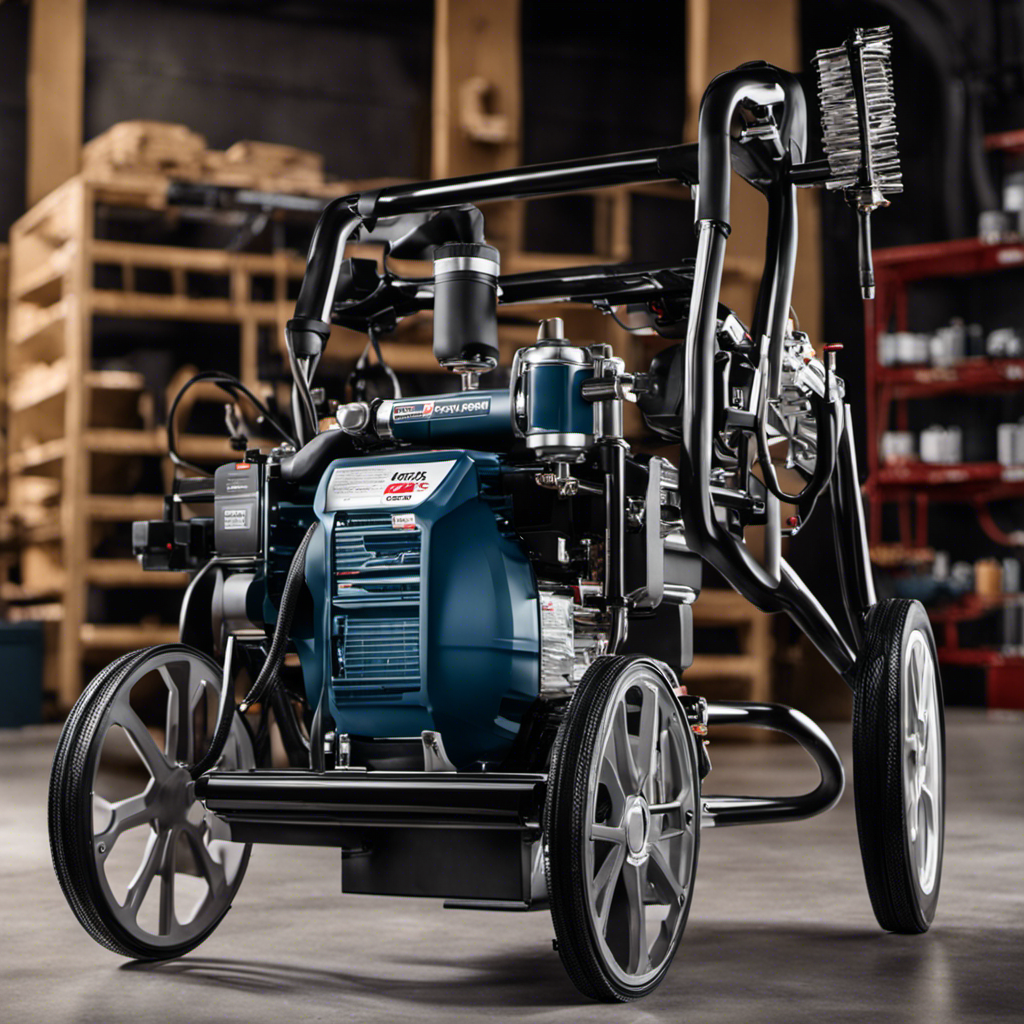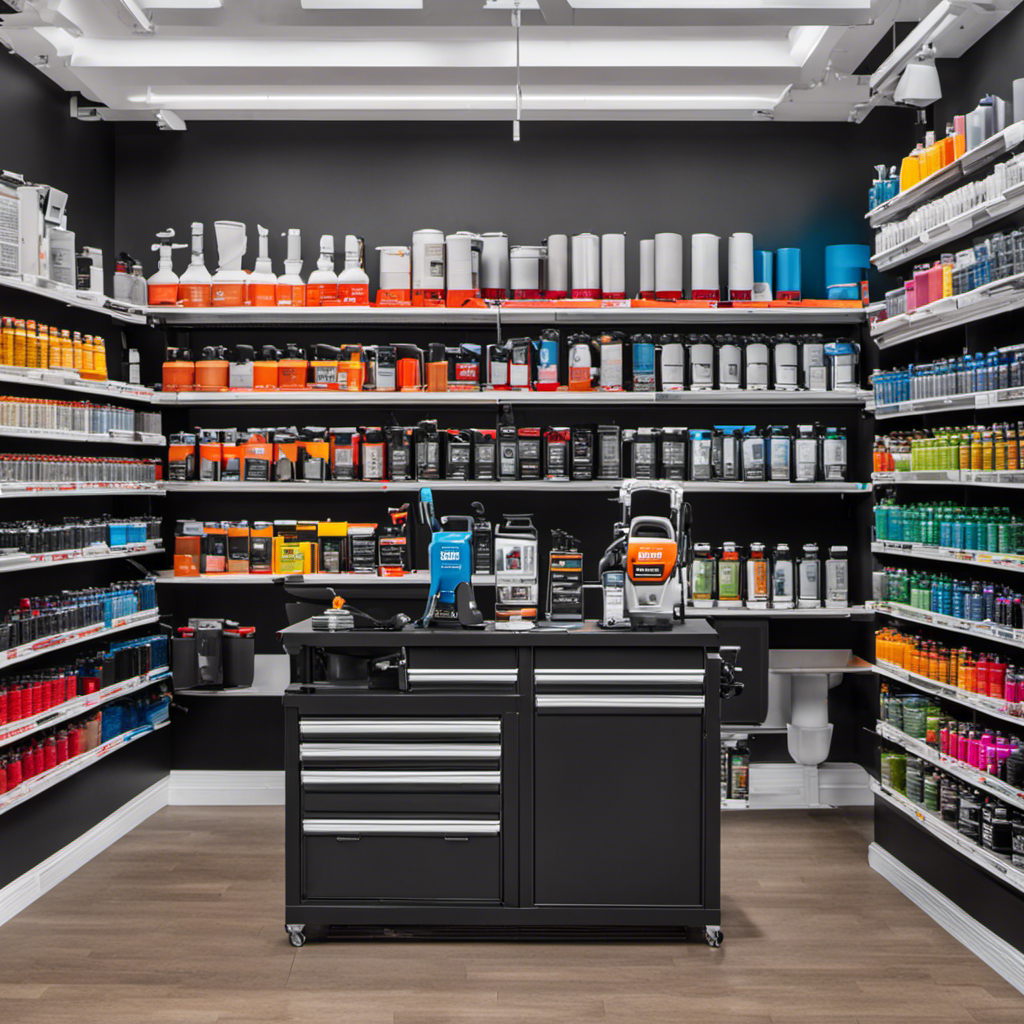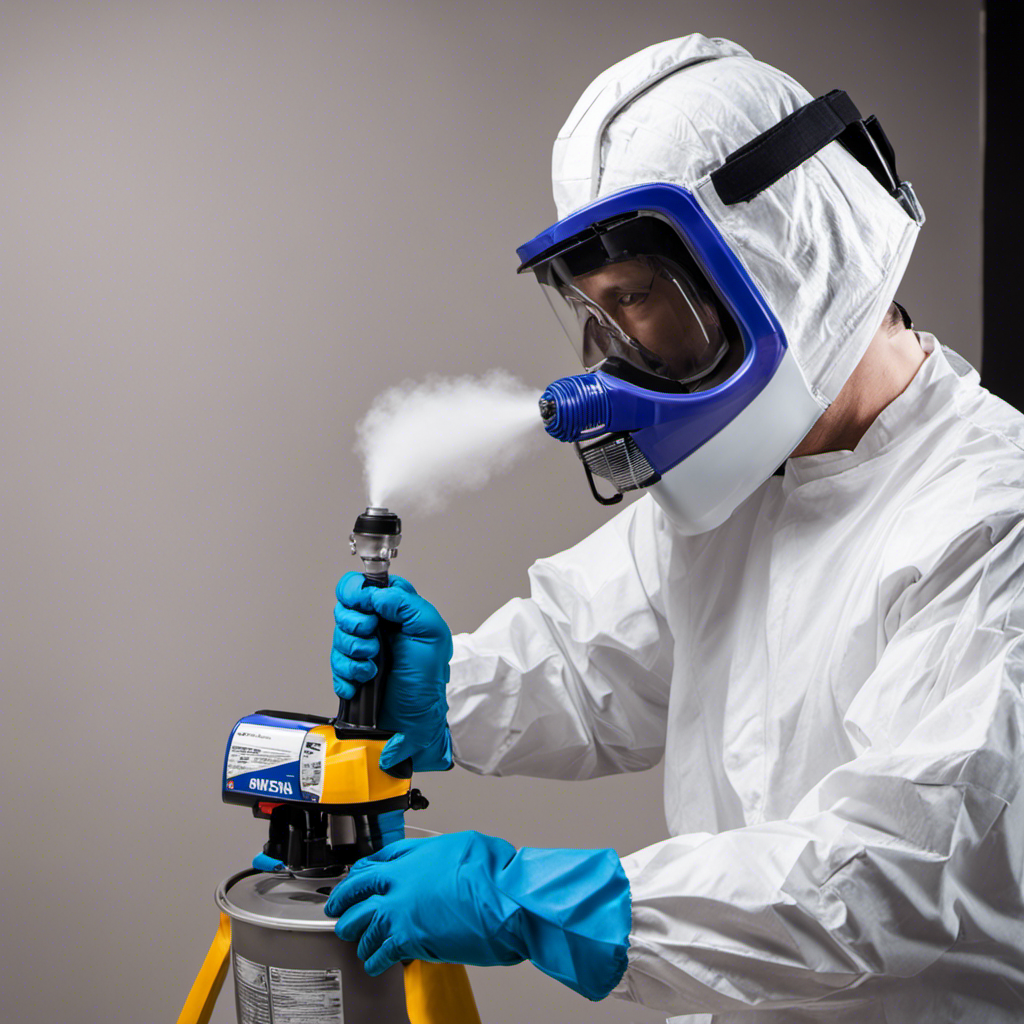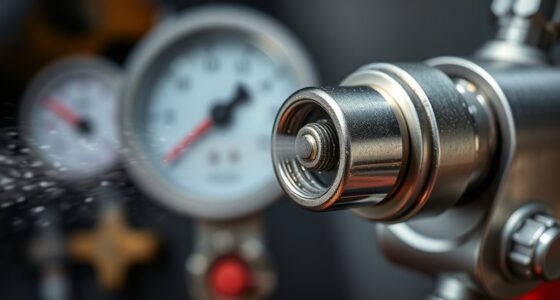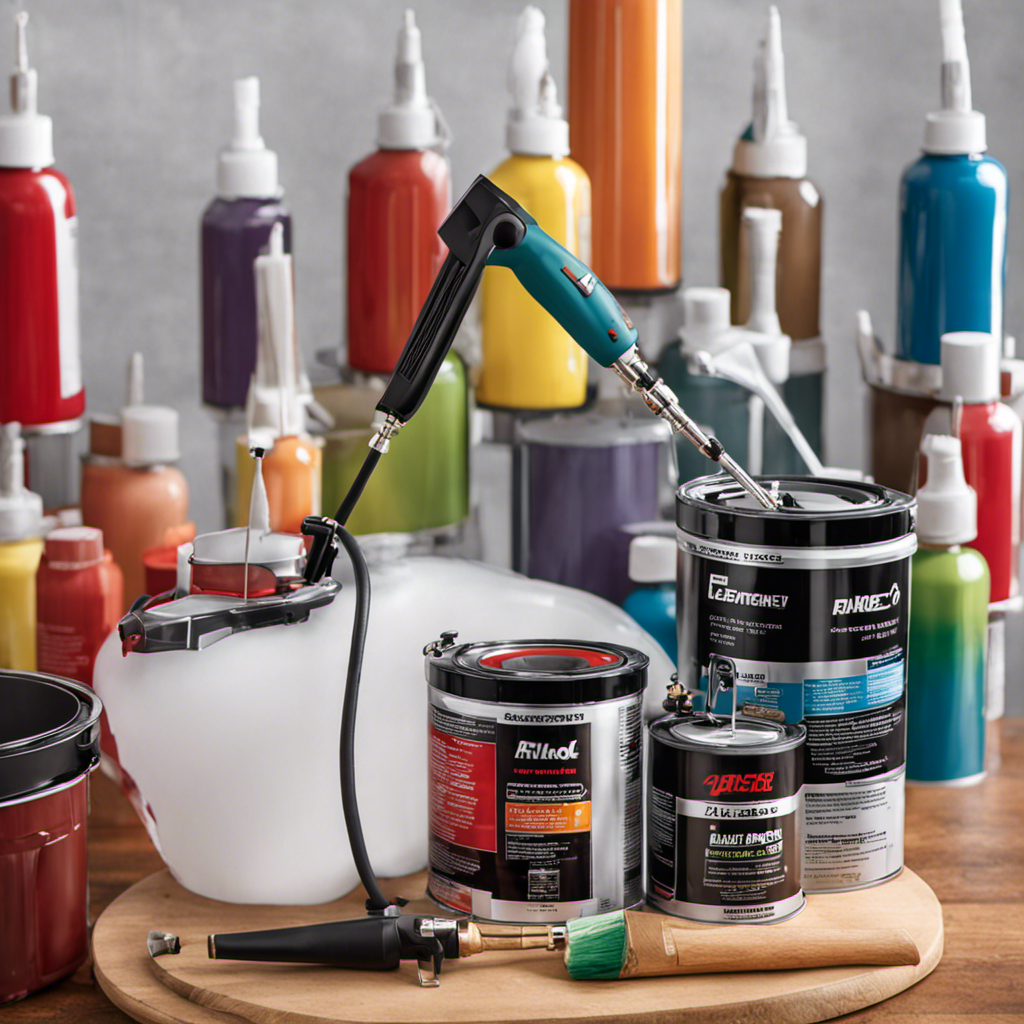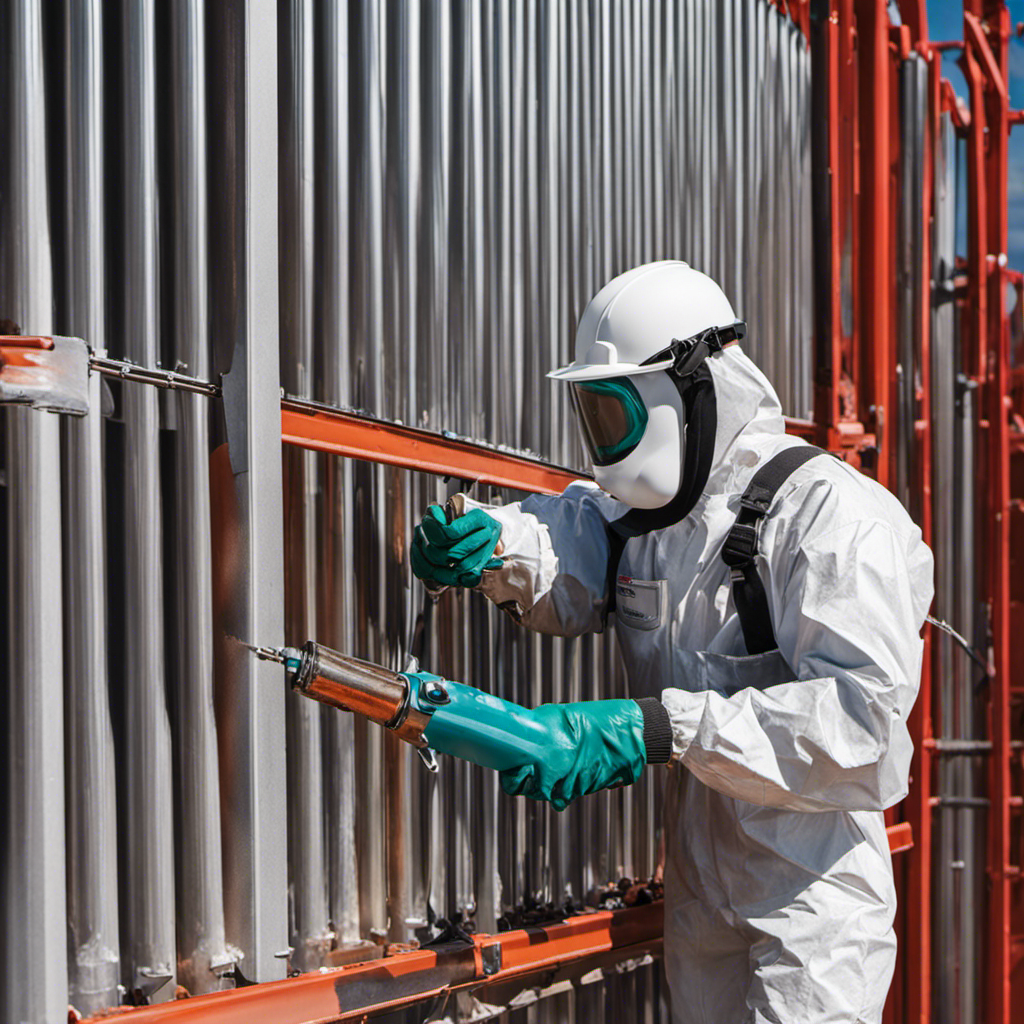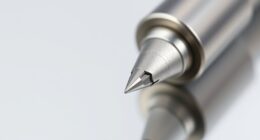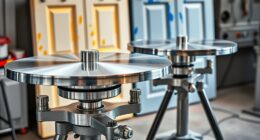Airless paint sprayers are a valuable tool for achieving uniform and smooth coatings. However, they may emit unusual and worrisome sounds. It is essential to grasp the significance of these noises in order to preserve the effectiveness and lifespan of your sprayer.
In this article, we delve into the world of airless paint sprayer noises. We explore the possible causes behind those loud clacking sounds that can make your heart skip a beat. From insufficient lubrication to loose parts, we’ll cover it all to ensure you’re equipped with the knowledge to tackle any noise-related issue.
Key Takeaways
- Regular maintenance and inspection are crucial for preventing and addressing noise-related issues in airless paint sprayers.
- Proper lubrication of moving parts and regular cleaning of filters are necessary for optimal performance.
- Different types of noises can indicate specific problems, such as loose or worn parts, motor or gear issues, damaged seals, clogs, or pressure control valve problems.
- Troubleshooting techniques include checking for loose or worn parts, inspecting the spray gun and tip for damage or clogs, adjusting pressure, and dealing with clogged or restricted filters.
Possible Reasons for Loud Clacking Sounds
The loud clacking sound in airless paint sprayers can be caused by factors such as insufficient lubrication, pump malfunction or wear, improper spraying techniques, and loose or worn parts.
Preventive measures can be taken to avoid these common paint sprayer issues. Regularly lubricating the moving parts of the sprayer can help reduce friction and prevent the clacking sound.
It is also important to properly maintain and inspect the pump to ensure it is functioning correctly and not causing any unnecessary noise. Using the correct spraying techniques and the right paint or thinners can also prevent the clacking sound from occurring.
Lastly, checking for loose or worn parts and replacing them as needed can help eliminate the clacking noise and ensure smooth operation of the paint sprayer.
Basics of Airless Paint Sprayers
High pressure is required for an even coating when using an airless paint sprayer. Proper maintenance and equipment handling are crucial to ensure optimal performance and longevity of the sprayer. Here are three key points to consider:
-
Regular Maintenance: Airless paint sprayers need to be properly maintained to prevent issues such as clogs, leaks, or pump malfunctions. This includes cleaning the filters, inspecting and lubricating the moving parts, and checking for any worn or loose components.
-
Equipment Handling: It’s essential to handle the airless paint sprayer with care and follow the manufacturer’s guidelines. Improper handling can lead to damage or premature wear of the sprayer, affecting its performance and potentially causing safety hazards.
-
Safety First: When working with an airless paint sprayer, always prioritize safety. Wear appropriate protective gear, such as goggles and gloves, and ensure proper ventilation in the painting area to avoid inhalation of fumes. Follow the recommended operating pressure and spraying techniques to achieve the best results while minimizing potential risks.
Identifying Different Types of Noises
Identifying different types of noises can provide valuable insights into potential issues with the airless paint sprayer. Common noise issues in airless paint sprayers can arise from various sources.
One of these is a clacking sound, which is often caused by loose or worn parts.
Another noise to watch out for is a grinding noise, which can indicate motor or gear problems.
Whining or squealing noises may be a result of worn or damaged seals.
A hissing sound can indicate nozzle clogs or pressure control valve issues.
Lastly, a rattling noise may be attributed to loose components inside the sprayer.
To prevent and fix noisy airless paint sprayers, it is crucial to regularly check for loose or worn parts, inspect the spray gun and tip, troubleshoot pressure adjustment issues, deal with clogged or restricted filters, and evaluate the condition of the pump.
Additionally, proper lubrication and painting technique should be followed for noise prevention.
Troubleshooting and Inspection
To troubleshoot and inspect an airless paint sprayer, one should start by checking for loose or worn parts. This is an essential step in identifying and resolving any issues with the sprayer.
Here is an inspection checklist and some troubleshooting techniques to help you in the process:
-
Inspect the spray gun and tip: Check for any damage or clogs in the spray gun and tip. Clean or replace them if necessary.
-
Troubleshoot pressure adjustment issues: Ensure that the pressure is set correctly for the type of paint being used. Adjust if needed.
-
Deal with clogged or restricted filters: Inspect the filters for any debris or blockages. Clean or replace them to ensure proper paint flow.
Proper Lubrication and Painting Technique
Proper lubrication and technique are crucial for maintaining an airless paint sprayer and achieving optimal results. Painting equipment maintenance is essential to ensure the longevity and efficiency of the sprayer. One of the key aspects of maintenance is the importance of proper lubrication. This helps to reduce friction, prevent wear and tear, and minimize noise during operation.
To emphasize the significance of proper lubrication in airless paint sprayers, the following table provides a detailed overview of the recommended lubricants for different parts of the sprayer:
| Sprayer Component | Recommended Lubricant | Frequency of Lubrication |
|---|---|---|
| Piston Rod | Grease or oil | Every 50 hours of use |
| Ball Bearings | Grease | Every 100 hours of use |
| Packing | Pump oil | Every 25 hours of use |
| Inlet Valve | Pump oil | Every 25 hours of use |
| Fluid Section | Pump oil | Every 25 hours of use |
Preventive Maintenance Tips
Regular maintenance is essential to keep airless paint sprayers in optimum condition and prevent potential issues. Here are three key benefits of regular maintenance and the importance of using the correct paint and thinners:
-
Extended Lifespan: By performing regular maintenance, such as cleaning and lubricating the sprayer, you can prolong its lifespan. This saves you money in the long run by avoiding costly repairs or the need for a new sprayer.
-
Consistent Performance: Regular maintenance ensures that your airless paint sprayer continues to deliver consistent and high-quality results. It helps prevent clogs, uneven spray patterns, and other issues that can compromise the finish of your paint job.
-
Safety: Using the correct paint and thinners is crucial to ensure the safety of both the operator and the environment. Using incompatible products can lead to hazardous chemical reactions, increased fumes, and potential health risks.
Conclusion and Final Thoughts
Regular maintenance is crucial for the proper functioning of airless paint sprayers. Neglecting maintenance can lead to various issues, including excessive noise production.
Improper spraying techniques can have a significant impact on noise levels. When the paint is not applied evenly or the wrong type of paint or thinners are used, it can cause the sprayer to work harder, resulting in increased noise.
Additionally, using incorrect spraying techniques, such as spraying too close to the surface or at the wrong angle, can also contribute to noise production. Therefore, it is essential to regularly inspect and maintain the sprayer to prevent excessive noise.
Frequently Asked Questions (FAQs
One common question is how to prevent excessive noise when using an airless paint sprayer. Here are three important things to keep in mind:
-
How to troubleshoot nozzle clogs: Nozzle clogs can cause a significant increase in noise levels. To troubleshoot this issue, start by turning off the sprayer and relieving the pressure. Remove the nozzle and clean it thoroughly with an appropriate solvent. Inspect the nozzle for any signs of damage or wear, and replace it if necessary.
-
Common mistakes in paint spraying techniques: Improper spraying techniques can contribute to excessive noise. Ensure that you are holding the sprayer at the correct distance from the surface and maintaining a consistent speed. Avoid spraying too quickly or using excessive pressure, as these can lead to splattering and increased noise levels.
Following these steps will help minimize noise and ensure a smoother painting process with your airless paint sprayer.
Additional Tips for Noise Prevention
To prevent excessive noise when using an airless paint sprayer, it is important to properly maintain and lubricate the equipment. This will not only ensure the longevity of the sprayer but also improve spraying efficiency and reduce noise levels.
One of the key noise reduction techniques is to regularly inspect and replace any loose or worn parts that may contribute to the clacking sound. Additionally, applying a suitable lubricant to the moving parts of the sprayer can significantly reduce friction and minimize noise.
It is also crucial to use proper spraying techniques and the correct paint and thinners to avoid unnecessary strain on the pump and motor, which can result in increased noise levels.
Frequently Asked Questions
Can I Use Any Type of Paint With an Airless Paint Sprayer?
Yes, any type of paint can be used with an airless paint sprayer, as long as it is compatible with the equipment. It is important to follow the manufacturer’s recommendations for paint compatibility and to use the appropriate paint thinners or additives if necessary.
Airless paint sprayers are versatile and can be used for a variety of applications, including painting walls, ceilings, furniture, and even exterior surfaces.
How Often Should I Lubricate the Airless Paint Sprayer?
Regular lubrication is crucial for the maintenance of an airless paint sprayer. It ensures smooth operation and helps prevent excessive noise.
To maintain optimal performance, the airless paint sprayer should be lubricated regularly, ideally every 50-75 hours of use. Applying lubricant to key areas such as the piston rod, packings, and moving parts will reduce friction and extend the lifespan of the sprayer.
Neglecting proper lubrication can lead to increased noise levels and potential damage to the equipment.
What Should I Do if I Hear a Rattling Noise Coming From the Sprayer?
If a person hears a rattling noise coming from the sprayer, they should first stop using it and perform troubleshooting maintenance.
They should check for loose components inside the sprayer and inspect the pump, spray gun, and tip for any damage. It is important to tighten any loose parts and replace any worn or damaged components.
Additionally, they should review the importance of proper cleaning and maintenance to prevent further issues and ensure optimal performance.
Are There Any Specific Safety Precautions I Should Take When Using an Airless Paint Sprayer?
When using an airless paint sprayer, it’s important to follow safety precautions to ensure a smooth and accident-free operation.
Best practices include:
- Wearing protective clothing, such as gloves, goggles, and a respirator, to prevent contact with paint and fumes.
- Ensuring proper ventilation in the workspace.
- Keeping the sprayer away from flammable materials.
Regular maintenance and inspection of the equipment are also necessary to prevent any potential hazards.
Can I Use the Airless Paint Sprayer for Other Types of Projects Besides Painting Walls?
Yes, the airless paint sprayer can be used for other types of projects besides painting walls. It can be used for painting furniture and automotive projects as well.
The high pressure of the sprayer ensures an even coating, making it suitable for various surfaces. However, it is important to use the appropriate paint and thinners, and to follow proper spraying techniques.
Regular maintenance and troubleshooting are also necessary to ensure optimal performance and prevent any noise issues.
Conclusion
In conclusion, it is crucial to understand the common noises in airless paint sprayers for maintaining optimal performance and achieving professional painting results. By identifying and addressing the causes of these noises, such as insufficient lubrication, pump malfunction, or loose parts, users can prevent further damage and ensure smooth operation.
One interesting statistic to note is that improper painting techniques and equipment issues account for approximately 80% of the noise problems in airless paint sprayers. Therefore, it is essential to follow proper lubrication procedures and employ correct spraying techniques to minimize noise and maximize efficiency.
Drenched in creativity and armed with a fountain pen, Isolde weaves words as gracefully as a painter strokes their canvas. A writer for Paint Sprayer Zone, her passion for colors, textures, and spaces finds a harmonious blend with her profound knowledge of painting tools and techniques.
Having grown up in a family of artists, Isolde’s tryst with paints began early. While her relatives expressed themselves on canvas, Isolde found her medium in words. She dedicated herself to chronicling the world of painting, understanding the nuances of each tool, and the artistry behind every spritz of a paint sprayer.
